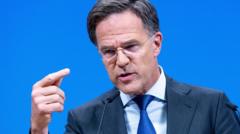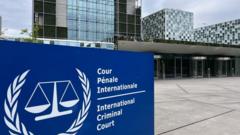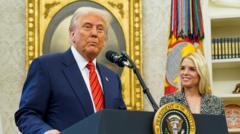In a bid to avoid criticism from former President Donald Trump, NATO's Secretary General Mark Rutte has suggested that member countries increase their defense spending to 5% of GDP. This proposal, aimed at appeasing the U.S. while possibly deterring Russia, represents a steep rise from the current target of 2%.
NATO's New Defense Spending Plan Aims to Satisfy Trump

NATO's New Defense Spending Plan Aims to Satisfy Trump
NATO's Secretary General Mark Rutte proposes a significant increase in defense spending to meet Donald Trump's expectations for European allies.
Article:
NATO Secretary General Mark Rutte is poised to present a bold new defense spending proposal aimed at winning favor with former U.S. President Donald Trump ahead of the upcoming NATO summit. Facing the memories of 2016, when Trump notoriously criticized European allies for inadequate defense spending and leveraging U.S. taxpayer contributions, Rutte seeks to reshape the narrative.
At a press conference held in Brussels, Rutte introduced the ambitious target of 5% of gross domestic product (GDP) for NATO member nations—a demand that Trump has long championed. This increase more than doubles the existing 2% spending commitment, presenting a considerable challenge for many European countries that may look at the initiative as both a means to deter Russia and also as a concession to appease Trump’s transactional view of international relations.
As discussions continue regarding NATO's defense spending, Rutte's plan aims to alleviate some pressures by suggesting that core defense spending should rise to 3.5% of GDP, while the additional 1.5% may come from "defense-related expenditures." This term could encompass expenses for infrastructure and industrial support, providing member states with some flexibility.
Remarkably, the U.S. is also set to adopt this forthcoming spending target, a comparatively easy task for them given their current defense outlay of 3.4%. The real challenge, however, will come in ensuring that member nations can meet this commitment over time, especially considering that many have yet to reach even the previous 2% target established over a decade ago.
There is no definitive timeline yet established for when countries are expected to meet the newly proposed target, but it is likely to span about a decade. Furthermore, NATO lacks meaningful sanctions to impose on nations that do not comply.
Rutte has pledged to hold leaders accountable by instituting annual plans to guarantee progress towards the 5% goal and avoid a "hockey stick" surge in spending as deadlines approach. As Rutte prepares to visit the UK next week to confer with Prime Minister Sir Keir Starmer, the advocated defense commitment lags behind the UK's current projections of 2.5% by 2027, with hopes to reach 3% thereafter.
U.S. Defense Secretary Pete Hegseth emphasized at the Brussels meeting that several key NATO countries, including France, Germany, Poland, and Nordic nations, have already expressed support for the 5% pledge, reinforcing the expectation that other members, including the UK, will follow suit. Hegseth expressed optimism that all nations would meet their commitments, recognizing the importance of the UK's participation in this defense plan.
NATO Secretary General Mark Rutte is poised to present a bold new defense spending proposal aimed at winning favor with former U.S. President Donald Trump ahead of the upcoming NATO summit. Facing the memories of 2016, when Trump notoriously criticized European allies for inadequate defense spending and leveraging U.S. taxpayer contributions, Rutte seeks to reshape the narrative.
At a press conference held in Brussels, Rutte introduced the ambitious target of 5% of gross domestic product (GDP) for NATO member nations—a demand that Trump has long championed. This increase more than doubles the existing 2% spending commitment, presenting a considerable challenge for many European countries that may look at the initiative as both a means to deter Russia and also as a concession to appease Trump’s transactional view of international relations.
As discussions continue regarding NATO's defense spending, Rutte's plan aims to alleviate some pressures by suggesting that core defense spending should rise to 3.5% of GDP, while the additional 1.5% may come from "defense-related expenditures." This term could encompass expenses for infrastructure and industrial support, providing member states with some flexibility.
Remarkably, the U.S. is also set to adopt this forthcoming spending target, a comparatively easy task for them given their current defense outlay of 3.4%. The real challenge, however, will come in ensuring that member nations can meet this commitment over time, especially considering that many have yet to reach even the previous 2% target established over a decade ago.
There is no definitive timeline yet established for when countries are expected to meet the newly proposed target, but it is likely to span about a decade. Furthermore, NATO lacks meaningful sanctions to impose on nations that do not comply.
Rutte has pledged to hold leaders accountable by instituting annual plans to guarantee progress towards the 5% goal and avoid a "hockey stick" surge in spending as deadlines approach. As Rutte prepares to visit the UK next week to confer with Prime Minister Sir Keir Starmer, the advocated defense commitment lags behind the UK's current projections of 2.5% by 2027, with hopes to reach 3% thereafter.
U.S. Defense Secretary Pete Hegseth emphasized at the Brussels meeting that several key NATO countries, including France, Germany, Poland, and Nordic nations, have already expressed support for the 5% pledge, reinforcing the expectation that other members, including the UK, will follow suit. Hegseth expressed optimism that all nations would meet their commitments, recognizing the importance of the UK's participation in this defense plan.




















